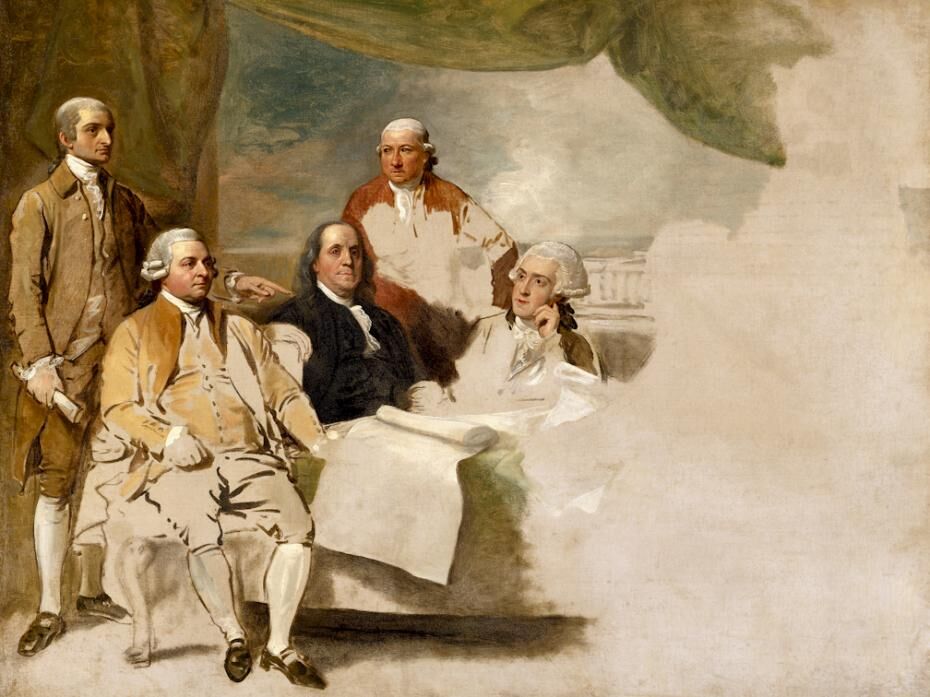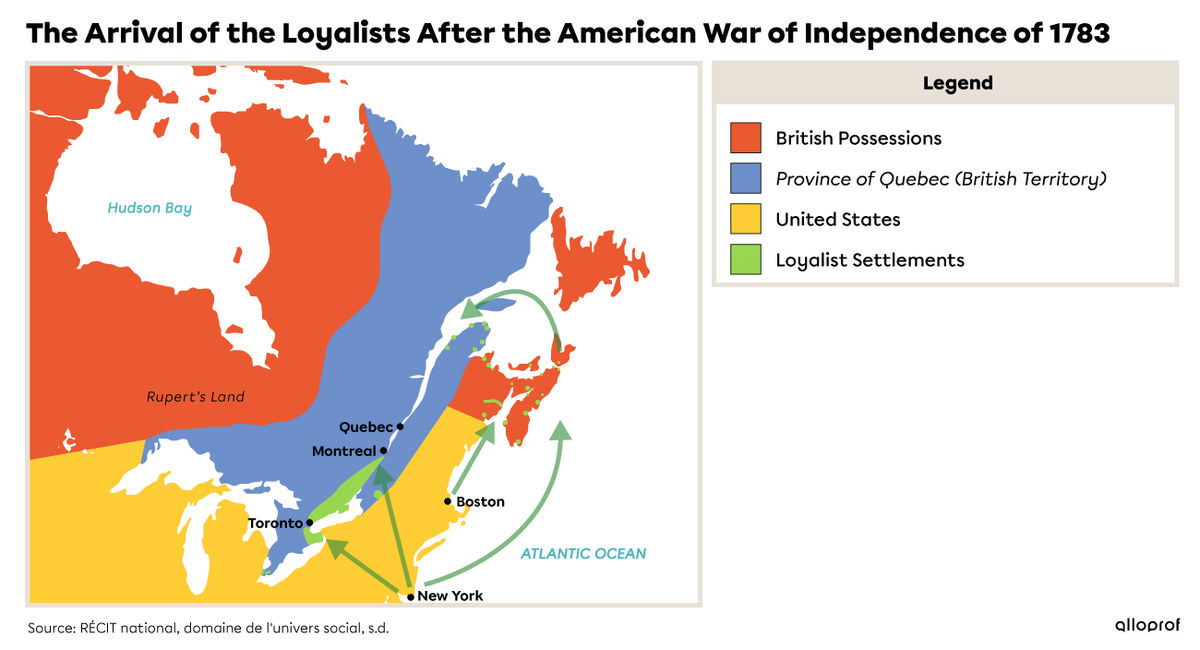On July 4, 1776, almost one year after the conflict started, the General Congress (also called the Continental Congress) adopted the United States Declaration of Independence. Even though the Thirteen Colonies declared their independence, Great Britain refused to let them go. The two sides continued their fighting. The United States won a significant battle in Yorktown in 1781 with aid from France, a major rival of Great Britain. The outcome of this battle prompted the British to negotiate a peace treaty. The Treaty of Paris was signed in 1783. This document confirmed the independence of the United States.

The British commissioners refused to pose for the artist, leaving the work unfinished.
Source: American Commissioners of the Preliminary Peace Negotiations with Great Britain [Peinture], West, B. 1783, The Met, (URL). Droits réservés*
Despite the loss of the Thirteen Colonies, Great Britain still had other colonies in North America. Among these, the Province of Quebec was most affected when the United States became independent.
The Treaty of Paris negotiations allowed the United States to take possession of the Ohio Valley, which it had claimed since the end of the Seven Years’ War in 1763. This territory was desirable because of its strategic position in the fur trade and had been ceded to the Canadiens when the Quebec Act was signed in 1774. The Great Lakes defined the new border, meaning the Province of Quebec lost all territories situated to the south of these lakes. This reality drove British merchants to explore west of the Great Lakes to continue exploiting the fur trade. To do so, they founded the North West Company. The biggest losers were Indigenous peoples because no territories were reserved for them.
Having lost their territory with the Treaty of Paris, the Six Nations of the Iroquois Confederacy and the Algonquins, who previously resided in the territory of the United States, decided to settle in the territory of the Province of Quebec. The Mi’kmaq, Maliseet and Abenaki were also displaced following this conflict. Many of them chose to reside in Indigenous communities from the same nation that were already located within the territory.
Following the Treaty of Paris, some inhabitants in the United States preferred to remain loyal to the British Crown. These were the Loyalists. Seen as traitors by the other citizens, they faced retaliation. As a result, approximately 100 000 of them left the United States.
Some Loyalists crossed the ocean to live in Great Britain, whereas others settled in various British colonies. The majority of them chose Nova Scotia. Faced with this significant increase in migrants, the British authorities founded Cape Breton and New Brunswick.
The Province of Quebec had more than 8 000 new immigrants. The King’s representatives offered them new land, mainly west of Montreal and north of Lake Ontario.

Source : The Coming of the Loyalists, 1783 [Toile], Sandham, H., (1925), Bibliothèque et Archives Canada, (URL).

Map of Loyalist settlements after 1783
The Loyalists experienced challenging times in the first few years after settling on the lands given to them in the English colonies. Despite clothing, food, seed and livestock donations from Great Britain, economic development was delayed because they had to clear the land, build new housing and establish communities. It took many years before they began to benefit from a certain amount of prosperity.
The Loyalists who settled in the Province of Quebec were very dissatisfied to learn that they would not only have to live as a minority in a mainly Francophone and Catholic population but would most importantly have to comply with laws and institutions that were not those traditionally found on territory belonging to Great Britain. Like the British merchants before them, many expressed their dissatisfaction in this regard. They demanded three things:
- enforcement of habeas corpus, a principle of British law
- the division of land into townships rather than based on the seigneurial system
- a Legislative Assembly and elections
London quickly responded to these demands. In 1784, habeas corpus was enforced in the colony. In 1786, the township system returned to the Province of Quebec. Finally, the British government began drafting a new constitution to replace the Quebec Act in 1790 with the goal of providing its subjects a Legislative Assembly.
Habeas corpus is a principle of British law that guarantees fundamental rights to individuals. A person cannot be imprisoned without first being tried.
Sandham, H. (1925). The Coming of the Loyalists, 1783 [Toile]. Bibliothèque et Archives Canada. https://www.bac-lac.gc.ca/fra/recherchecollection/Pages/notice.aspx?app=fonandcol&IdNumber=2895488 no d'acquisition 1996-282-7
West. B. (1783). American Commissioners of the Preliminary Peace Negociations with Great Britain [Peinture]. The Met. https://www.metmuseum.org/art/collection/search/656864. *Extrait employé par Alloprof conformément à la Loi sur le droit d’auteur dans le cadre d’une utilisation équitable aux fins d’éducation [https://laws-lois.justice.gc.ca/fra/lois/c-42/page-9.html].